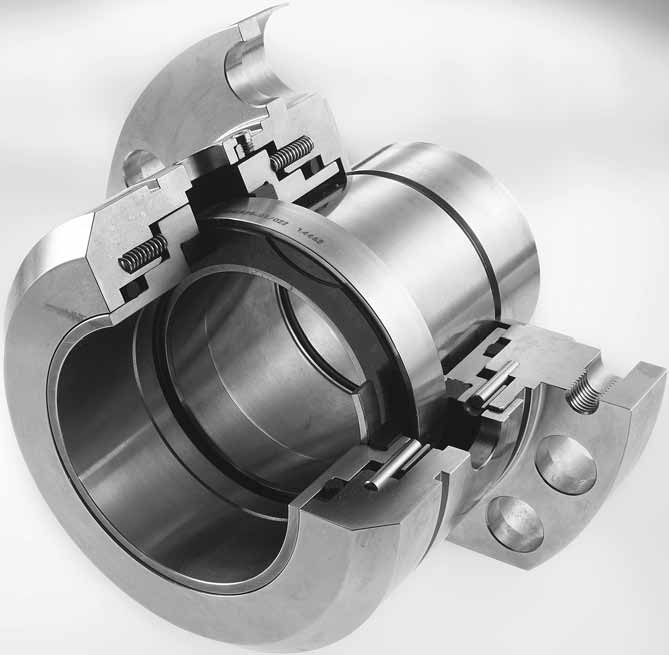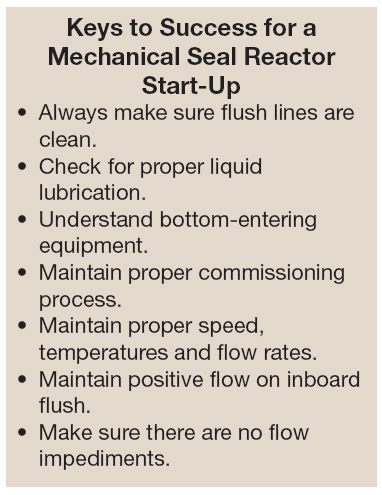Due to heat-shrink technology, agitator seal functions failure free for more than a decade.
The year 1997 started with some memorable events depending on your political and/or sporting interests. On January 20, President Bill Clinton was inaugurated for his second term of office, and later in the month, on January 26, the Green Bay Packers won 35 to 21 over the New England Patriots during Super Bowl XXXI. In the world of mechanical sealing, an agitator seal was installed in a high-pressure reactor of a plastics company in Point Comfort, Texas. At that time, the seal manufacturer had no way of knowing that 13 years later, this seal would prove to be a major success story.

Agitator seal
This agitator seal is a mechanical seal designed for process-oriented applications—such as the chemical pharmaceutical industry and tight-tolerance, clean-in-place and aseptic environments. The seal offers high reliability and long service life, upwards of 15 to 20 years or more. This long service life is due to a proprietary heat-shrink technology featuring a hard-on-soft seal face combination. With this technology, the seal offers increased lubrication properties and more precise temperature control at the seal face.
Polypropylene Process Problems
In this particular application, the plastics company, a producer of polypropylene, discovered leakage on both the inboard and outboard portions of the seal, following a system disruption. The reactor had to be shutdown and all production curtailed so that the seal could be removed from service and repaired.
The agitator seal was in good condition, even after 13 years of service. A system upset had caused the seal to fail. Without this, it would probably have had a life expectancy of longer than 13 years.
Polypropylene production is a problematic process and can be “finicky” at times. In the agitator, polypropylene must be in a malleable state and kept at a constant temperature and molecular weight for proper processing. If the material becomes contaminated or solidified, the batch has to be discarded. During part of the process, the polypropylene is a very fine powder and care must be taken to avoid back-up into the seal and to prevent the powder from coming into contact with the fluid used to flush the seal.
Unfortunately, there were some system disturbances that caused the seal to fail. The polypropylene production process requires the reactor to run at very high pressures (650 psi) and very slow speeds (approximately 26 rpm)—a real nightmare production scenario.
Typically, agitator seals last only about five years, and even less, depending on the pressures and speeds used in an application. Some production facilities do not expect more than a two-year lifespan. That this seal ran for 13 years is a major accomplishment.
Reactor downtime became an enormous financial burden for the polypropylene facility. When the reactor was down, the company estimated that it lost approximately $1.2 million per week. It took a few days to make repairs and get the system up and running every time the agitator went down.
Strategic Seal Repair
Overall, the seal showed normal wear on most areas. On dismantling the seal, the seal manufacturer's engineers determined that the seal had not had an adequate velocity (15 feet/second) of propylene flush under the carbon bushing to ensure that the inboard seal was not exposed to the polypropylene. Polypropylene passing under the carbon bushing into the flushing cavity caused excessive product build-up over a long period.
This product accumulation resulted in deflection of the carbon bushing and bending of the drive pins on the carbon-bushing clamp ring, chipping on the inner diameter of the inboard rotating carbon and possible hang-up of the inboard rotating face. All consumables, o-rings, set screws and cap screws were intact and in working condition.

The seal manufacturer has repair facilities throughout the U.S. One of these facilities was not far from the plastics company, and personnel were able to quickly pick-up the inboard seal for repair and return it to the customer over a short time period.
Due to the size (13 inches) and nature of this type seal, the standard repair time would be a minimum of 3 to 4 weeks and sometimes up to eight weeks. The repair facility was able to turn around the seal in less than five days—a huge cost and time savings for the plant.
When the repair personnel pulled the seal apart, they found a large ring of polypropylene dust that had built-up inside the seal faces. This build-up prevented proper material flow from one area to another, and eventually, the seal began to leak. Once material begins to leak, it is a safety issue, not only for process contamination but also, more importantly, for personnel considerations.
To prevent future malfunctions, the seal manufacturer's engineers worked closely with the plastics company personnel to implement several system changes. They suggested the installation of pressure gauges and flow control valves to monitor the flow of propylene fluid. This would help ensure that the inboard seal faces remain in a clean process on the product side of the faces. The plant operators were given a checklist of procedures to follow before starting up the reactor to make sure that all the equipment was operating safely and properly.
Another 13 Years
The seal manufacturer visits the company bimonthly. During these visits, the personnel do a walk-through and check the agitator to make sure that everything is working correctly. The real key to why the seal performed so well for 13 years lies in the shrink-face technology. The hard-on-soft seal configuration allows the seal to provide better lubricity, especially in a difficult process such as polypropylene production, while providing the same strength and quality as a hard-on-hard seal face.
Whenever a production system malfunctions, product loss and waste can quickly lead to financial concerns. For the polypropylene process, downtime to repair the reactor severely affected the company's bottom line.
The manufacturer's proximity to the plastics company and its ability to fix the seal in just a few days prevented massive product loss and ultimately saved the company money by deterring future shutdowns. Suggested process improvements and guidelines, along with check-ups will ensure that all equipment is in good working order.
The agitator is up and running successfully and is expected to run for another 13 years.
Pumps & Systems, September 2011

